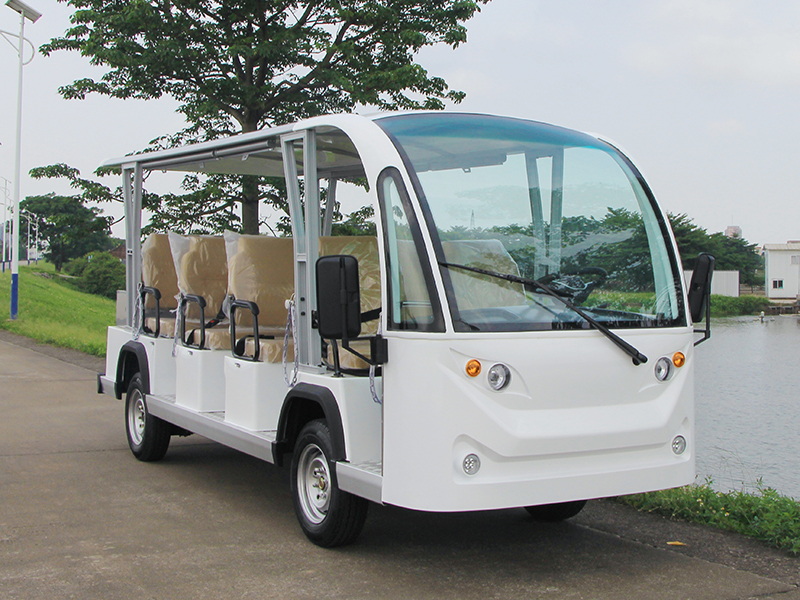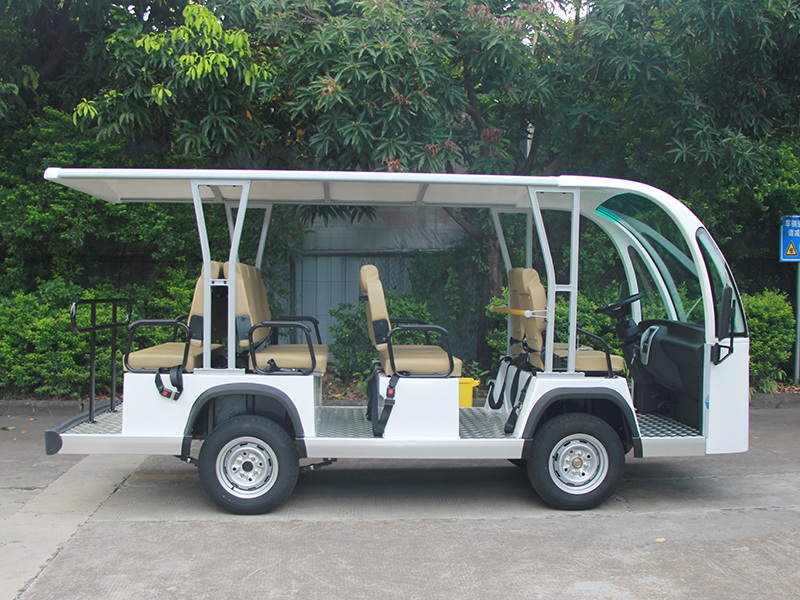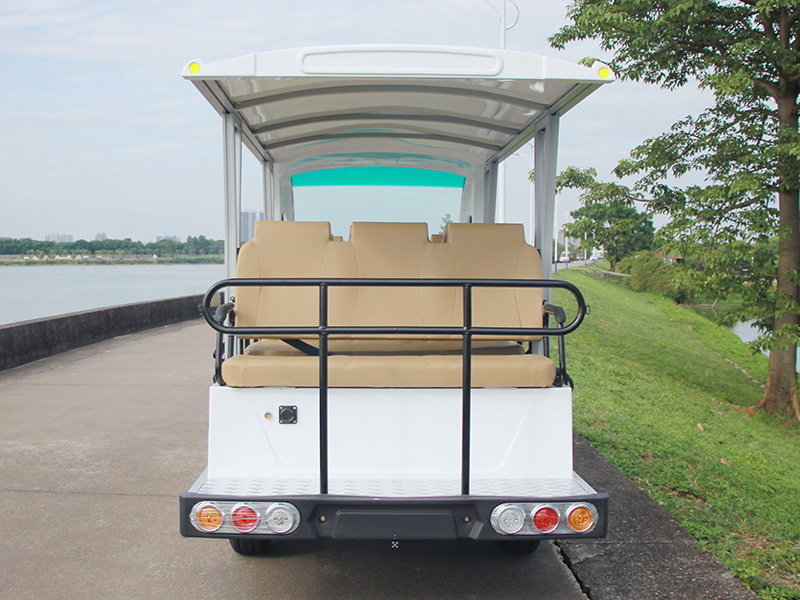Content Menu
● Leading Electric Sightseeing Bus Makers and Their Product Lines
>> LangQing Electric Sightseeing Carts and Related Products
● Understanding the Electric Sightseeing Bus Market
● Key Design Considerations for Comfort and Range
>> 1. Passenger Comfort
>> 2. Range and Battery Technology
>> 3. Structural Innovations and Safety
>> 4. Technological Integration for Enhanced Experience
● Examples of Electric Sightseeing Buses Designed for Comfort and Range
>> LangQing Electric Sightseeing Carts
>> Panoramic Electric Double Decker Imperial Bus
>> Ankai 12M Electric Double Decker Sightseeing Bus
>> Customizable Electric Sightseeing Buses by XUNHU
● Conclusion
● FAQ
>> 1. What factors influence the range of an electric sightseeing bus?
>> 2. How do electric sightseeing buses ensure passenger comfort?
>> 3. What types of batteries are used in electric sightseeing buses?
>> 4. How long does it take to charge an electric sightseeing bus?
>> 5. Are electric sightseeing buses suitable for hilly or steep areas?
Electric sightseeing buses have become a popular choice for urban tours and scenic routes worldwide due to their eco-friendly nature, quiet operation, and ability to offer a unique passenger experience. Designing these buses to maximize both comfort and range is a complex task that involves innovation in vehicle architecture, battery technology, passenger amenities, and safety features. This article explores how electric sightseeing bus makers achieve this balance, highlighting key design elements, technological advancements, and practical considerations.

Leading Electric Sightseeing Bus Makers and Their Product Lines
Before diving into design specifics, it is important to highlight a prominent manufacturer in the electric sightseeing vehicle sector-LangQing Electric Vehicles, a well-established Chinese company with over 24 years of experience in electric vehicle manufacturing. LangQing specializes in a wide range of electric vehicles including electric sightseeing carts, golf carts, mini trucks, patrol carts, ambulance carts, towing tractors, and customized vehicles.
LangQing Electric Sightseeing Carts and Related Products
LangQing's product portfolio includes:
- Electric Sightseeing Carts: Designed for resorts, parks, campuses, and tourist areas, these vehicles prioritize passenger comfort, safety, and environmental friendliness. They come in various seating capacities and configurations to suit different tour needs.
- Electric Golf Carts: Available in 2 to 8 seats, LangQing's golf carts are popular for golf courses, hotels, and communities worldwide.
- Electric Mini Trucks: Compact and versatile, suitable for logistics and maintenance in large facilities.
- Electric Patrol Carts: Used by security and maintenance personnel for efficient patrolling.
- Electric Ambulance Carts: Specialized carts designed for emergency medical transport within campuses or resorts.
- Electric Towing Tractors: Heavy-duty vehicles for towing and logistics support.
LangQing's manufacturing plant is ISO certified with a strict quality management system. Their patented chassis design features a high-strength steel frame with electrophoresis and plastic spraying anti-rust treatment, ensuring durability and longevity. They also offer OEM and ODM services, enabling customers to customize vehicles according to brand or operational needs.
With clients across more than 50 countries and projects in major international events, LangQing stands as a benchmark for quality and innovation in electric sightseeing and utility vehicles.
Understanding the Electric Sightseeing Bus Market
Electric sightseeing buses are purpose-built vehicles designed to transport tourists around cities or scenic locations with zero emissions and minimal noise pollution. They come in various configurations including:
- Double-decker electric sightseeing buses with open or glass dome tops for panoramic views.
- Low-floor electric buses designed for easy boarding, especially for elderly and disabled passengers.
- Custom-built electric buses tailored to specific client needs, such as seating capacity or battery size.
These buses are increasingly favored by cities aiming to reduce carbon footprints while enhancing the tourist experience.
The growing demand for sustainable tourism solutions has pushed electric sightseeing bus makers to innovate rapidly. Cities with historic centers, parks, and tourist hotspots now prefer electric buses to preserve air quality and reduce noise, which enhances the overall visitor experience. Moreover, government incentives and stricter emission regulations have accelerated the adoption of electric buses in the sightseeing sector.

Key Design Considerations for Comfort and Range
1. Passenger Comfort
Electric sightseeing bus makers prioritize passenger comfort to ensure a pleasant and memorable ride. Key features include:
- Seating and Space: Ergonomically designed seats with ample legroom and sometimes reclining features. For example, the Ankai 12M Electric Double Decker Sightseeing Bus offers high-end seats with USB charging ports for passenger convenience. The seat materials are often chosen for durability and ease of cleaning, while providing cushioning that supports longer rides without discomfort.
- Climate Control: Air conditioning and heating systems maintain a comfortable temperature regardless of weather conditions. The Ankai bus includes overhead A/C with a cooling capacity of 30,000 Kcal/h. Many manufacturers also integrate air purification systems to improve air quality inside the bus, which is especially important in urban environments.
- Large Viewing Windows: Wide, transparent windows or open-top designs maximize sightseeing opportunities. The panoramic electric double-decker Imperial bus features a transparent and bright interior with a flat floor for easy movement. Some buses also use UV-protective glass to shield passengers from harmful sun rays while maintaining visibility.
- Accessibility: Low-floor designs facilitate easy boarding and alighting, especially for people with mobility challenges, lowering the vehicle's center of gravity to improve stability and safety. Many electric sightseeing bus makers also include ramps or lifts for wheelchair users, ensuring inclusivity.
- Noise Reduction: Electric motors produce less noise than diesel engines, creating a serene environment for sightseeing. Additionally, manufacturers use soundproofing materials inside the cabin to further reduce road and mechanical noise, enhancing passenger comfort.
2. Range and Battery Technology
Range is a critical factor for electric sightseeing buses, as it determines how far the bus can travel on a single charge, directly impacting operational efficiency.
- Battery Capacity and Type: Most modern electric sightseeing buses use lithium-ion or lithium iron phosphate batteries for their high energy density and long life. For instance, the panoramic double-decker Imperial bus uses a 450 kWh lithium iron phosphate battery. These batteries are favored for their thermal stability and safety, reducing the risk of overheating.
- Energy Management: Efficient powertrain design and regenerative braking systems help extend range by recovering energy during stops. Advanced battery management systems (BMS) monitor battery health and optimize charging cycles to prolong battery life.
- Charging Time: Fast charging capability is essential for minimizing downtime. The Imperial bus can be charged fully in 3 to 4.5 hours depending on the charger power. Some electric sightseeing bus makers also offer opportunity charging solutions, allowing buses to recharge during short stops at tourist attractions or terminals.
- Travel Range: Typical ranges vary from 80 to 240 km depending on battery size, load, and use of air conditioning. The Ankai double-decker bus can travel up to 240 km without air conditioning, while other models offer 80-100 km per charge. This range is generally sufficient for a full day of sightseeing tours in most cities.
- Weight Optimization: Lightweight materials and monocoque body frames reduce overall vehicle weight, improving range and handling. Use of aluminum alloys, composites, and high-strength steel helps maintain structural integrity while minimizing weight.
3. Structural Innovations and Safety
Electric sightseeing bus makers incorporate advanced structural designs and safety features to enhance passenger security and vehicle durability:
- Low-Floor Full-Bearing Body Structure: This design uses a double-layer truss frame with a floor height of approximately 360 mm, reducing steps and lowering the center of gravity for improved stability and safety. This structure also improves ride quality by reducing vibrations.
- Safety Systems: Modern buses include collision warning, emergency braking, lane departure assist, ABS, and pneumatic brakes to ensure safe operation. Some models are equipped with 360-degree cameras and sensors to assist drivers in navigating crowded tourist areas.
- Accessibility Features: Dedicated wheelchair areas and flexible handrails accommodate diverse passenger needs. The layout is carefully designed to ensure smooth passenger flow during boarding and disembarking.
- Corrosion Resistance: Electrophoresis coating processes improve the bus body's resistance to weather and corrosion, extending vehicle lifespan. This is especially important for buses operating in coastal or humid environments.
4. Technological Integration for Enhanced Experience
Electric sightseeing bus makers are increasingly integrating smart technologies to improve both operational efficiency and passenger experience:
- Infotainment Systems: Touchscreen displays, audio guides, and Wi-Fi connectivity allow passengers to learn about landmarks during the tour.
- Real-Time Monitoring: Fleet operators can track battery status, vehicle location, and maintenance needs remotely, ensuring reliable service.
- Customizable Interiors: Some manufacturers offer modular interiors that can be adapted for different tour types, including VIP seating or standing-room options.
Examples of Electric Sightseeing Buses Designed for Comfort and Range
LangQing Electric Sightseeing Carts
- Seating capacities vary to suit different environments such as resorts, parks, and campuses.
- Durable chassis with patented high-strength steel frame and anti-rust treatment.
- OEM and ODM customization services including brand logos, body designs, and interior configurations.
- Proven reliability with clients in over 50 countries.
- Range and battery specifications tailored to operational needs, balancing comfort and efficiency.
Panoramic Electric Double Decker Imperial Bus
- Seats up to 79 passengers.
- Uses a 450 kWh lithium iron phosphate battery.
- Charging time between 3 to 4.5 hours.
- Features a flat floor, ergonomic seats, and a versatile open-top design with optional tarpaulin.
- Provides a bright and transparent interior for enhanced sightseeing.
- Equipped with advanced air conditioning and safety systems.
Ankai 12M Electric Double Decker Sightseeing Bus
- Seats 72 passengers (50 upper deck, 18 lower deck, plus driver).
- Equipped with a 314 kWh lithium battery and ZF motor.
- Offers a range of up to 240 km without air conditioning.
- Includes USB charging ports, air suspension, and advanced safety features.
- Uses electrophoresis process for corrosion resistance and a monocoque body frame for lightweight strength.
- Features a low-floor design for easy accessibility.
Customizable Electric Sightseeing Buses by XUNHU
- Seating capacity ranges from 8 to 23 seats.
- Range of 80-100 km per charge.
- Climbing ability of 20%-30% under load.
- Designed for urban and resort environments with tailored configurations.
- Offers flexibility in interior layouts and battery options.
Conclusion
Electric sightseeing bus makers successfully balance comfort and range by integrating advanced battery technologies, ergonomic passenger amenities, and innovative structural designs. These buses offer a sustainable, quiet, and enjoyable way to explore cities and scenic areas, meeting the needs of both operators and passengers. With ongoing improvements in battery efficiency, charging infrastructure, and vehicle design, the future of electric sightseeing buses looks promising for expanding eco-friendly tourism worldwide. As cities continue to prioritize sustainability and visitor experience, electric sightseeing buses will play an increasingly vital role in shaping green urban mobility and tourism.

FAQ
1. What factors influence the range of an electric sightseeing bus?
The range depends on battery capacity, vehicle weight, load, terrain, use of air conditioning, and driving style. Efficient power management and regenerative braking also extend range.
2. How do electric sightseeing buses ensure passenger comfort?
Comfort is ensured through ergonomic seating, climate control systems, large viewing windows, low-floor designs for easy access, and noise reduction from electric motors.
3. What types of batteries are used in electric sightseeing buses?
Most use lithium-ion or lithium iron phosphate batteries due to their high energy density, long lifespan, and safety characteristics.
4. How long does it take to charge an electric sightseeing bus?
Charging times vary; for example, the Imperial double-decker bus charges fully in 3 to 4.5 hours depending on charger power.
5. Are electric sightseeing buses suitable for hilly or steep areas?
Yes, many models have climbing abilities of 20%-30% even when fully loaded, making them suitable for varied terrains.










































